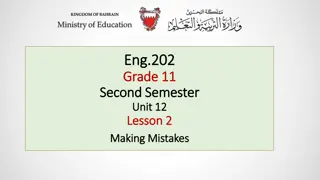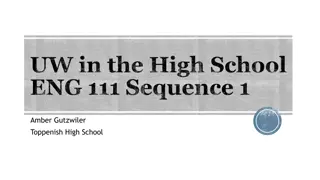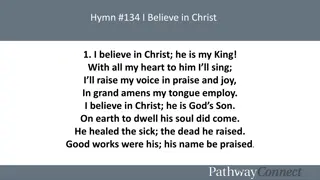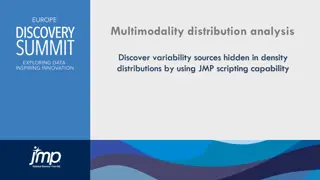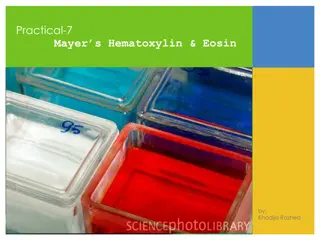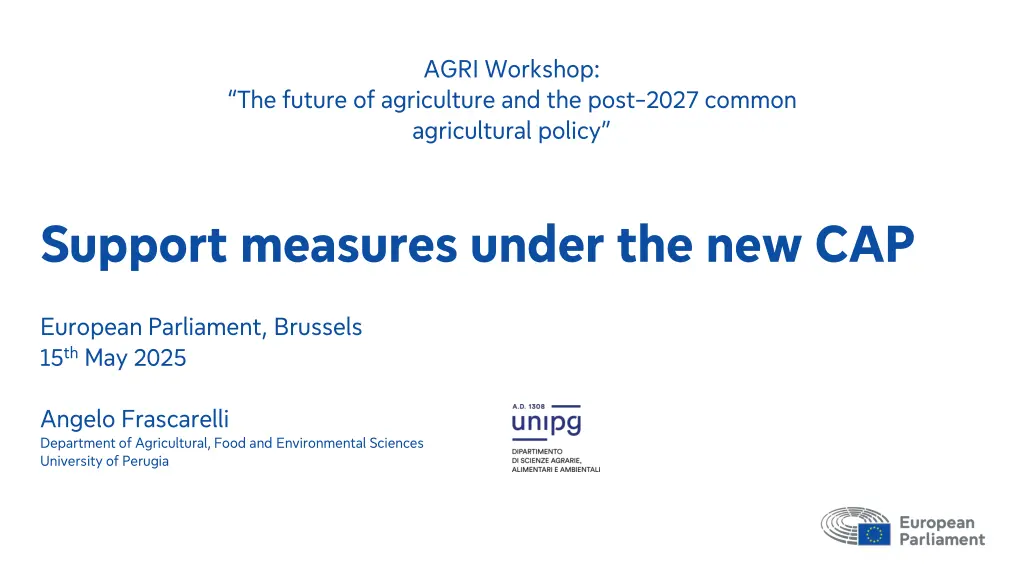
Evolution of Income Support in Agricultural Policy Towards Sustainability
Explore the evolution of income support within agricultural policies, focusing on the Common Agricultural Policy (CAP) and the shift towards sustainability. From historical support mechanisms to the current CAP (2023-2027), the discussion delves into challenges and alternative hypotheses for effective support allocation. Key considerations include balancing income support for farmers in need and remuneration for public goods through initiatives like ecoschemes. Moreover, critical assessment is made on the criteria for distributing direct payments based on the utilised agricultural area (UAA) and its implications for farm sizes and sustainability goals.
Download Presentation

Please find below an Image/Link to download the presentation.
The content on the website is provided AS IS for your information and personal use only. It may not be sold, licensed, or shared on other websites without obtaining consent from the author. If you encounter any issues during the download, it is possible that the publisher has removed the file from their server.
You are allowed to download the files provided on this website for personal or commercial use, subject to the condition that they are used lawfully. All files are the property of their respective owners.
The content on the website is provided AS IS for your information and personal use only. It may not be sold, licensed, or shared on other websites without obtaining consent from the author.
E N D
Presentation Transcript
AGRI Workshop: The future of agriculture and the post-2027 common agricultural policy Support measures under the new CAP European Parliament, Brussels 15thMay 2025 Angelo Frascarelli Department of Agricultural, Food and Environmental Sciences University of Perugia
Table of contents 1. Income Support 2. Carbon Farming under CAP
Income Support in the CAP 01
Income Support Evolution of CAP Support From its inception (1962) to 1992 Common internal market support, coupled with prices Partially decoupled support (compensatory payments), coupled payments for some crops and livestock Mac Sharry Reform (1993-2004) Totally decoupled support (direct payments), coupled payments for some crops and livestock Fischler Reform (2005-2014) Totally decoupled support (direct payments), with 7 payments for more targeted support (basic, greening, young farmers, etc.) CAP 2014-2022 4
Income Support CAP Support 2023-2027 The current CAP (2023-2027) has generated a further targeting of support with a basic payment, to which ecoschemes are added. The main form of support (Basic Income Support for Sustainability - BISS) pursues a dual objective: income support; remuneration of public goods, through conditionality. But can a single payment for two different objectives be effective? Alternative hypothesis with two supports, one for each objective: an income support for the farmers most in need; a support for the remuneration of public goods (e.g. ecoschemes). 5
Income Support Current Income Support Criteria Since 1993, the main parameter of CAP support has been the utilised agricultural area (UAA). The scientific community emphasises: questions about the adequacy of the current system of public support based on UAA; the UAA-based system: it benefits the largest and most capital-intensive farms; ineffective for smaller, sustainable farms; land ownership is rewarded over actual labour and production, creating a system that favours the wealthiest farm owners; need to re-evaluate the criterion for allocating direct payments to better align them with the EU s equity and sustainability objectives. 6
Income Support Improve the effectiveness of direct payments One study evaluated some alternative support allocation criteria: utilised agricultural area (UAA); annual work unit (AWU); value added (VA); labour per hectare (AWU/UAA); value added per hectare (VA/UAA); value added per work unit (VA/AWU). High High income and highly sustainable farms Low income and highly sustainable farms Environmental Sustainability Parameters might be able to: 1. increase the fairness and effectiveness of CAP direct payments; 2. pursuing both objectives of environmental sustainability and income support. Low income and low sustainable farms High income and low sustainable farms Low Income High Low 7
Income Support Our study: best allocation criteria among states Best parameter to remunerate sustainable farmers Best parameter to remunerate farmers most in need The study is based on: FADN data; analysis by MS; more sustainable farmers based on the use of pesticides and fertilisers; 6 alternative criteria: UAA, AWU, VA, AWU/UAA, VA/UAA, VA/AWU. 8
Income Support Alternative criteria for resource allocation (1) A single criterion is not always valid for the simultaneous pursuit of both objectives: income support; environmental sustainability. Is more appropriate: a payment for income support for the farmers most in need; a payment for the production of environmental public goods (e.g. ecoschemes). Our findings suggest that support allocation based on alternative indicators to land (UAA) can redistribute support more equitably and effectively, benefiting smaller and more sustainable operations. Furthermore, the criterion for allocating support could be differentiated by Member State, also taking into account the heterogeneity within the Regions of the individual States. 9
Income Support Alternative criteria for resource allocation (2) administratively simple; politically stable, as it provides predictable financial support to farmers. Advantages UAA (utilised agricultural area) favours land ownership (land rent revenues) over labour in actual production; benefits larger, capital-intensive farms; ineffective for smaller, sustainable farms. Disadvantages greater focus on smaller and labour-intensive farms, which are often more integrated into rural communities and more focused on landscape management and agro-ecological resilience. Advantages AWU/UAA (labour per hectare) identification of standard AWU/UAA payments for each agricultural activity; risk of decommissioning of extensive agriculture farming systems. Disadvantages There is no perfect criterion for the allocation of support. UAA has many disadvantages, but the other criteria also have advantages and disadvantages. 10
Carbon Farming under CAP Support for Carbon Farming Carbon farming plays a key role in meeting EU climate neutrality goals. Recent Developments: Regulation (EU) 2024/3012 has set out criteria for certifying carbon sequestration in agricultural practices; The regulation aims to create a transparent and credible carbon credit market, rewarding farmers for their role in climate mitigation. 12
Carbon Farming under CAP Options for Carbon Farming (CF) under CAP Options Description 1 - Status quo Both CAP pillars, while certification of credits is not supported. CF is supported: primarily from CAP first pillar, through ecoschemes; from the second pillar of the CAP, to incentivise a harmonised certification system. 2 - Only CAP (first and second pillar) 3 - Only voluntary carbon credit market CF is paid only by the market, through the sale of carbon credits. The CAP budget decreases (e.g. from the current 32% of the Multiannual Financial Framework to 25%) and the loss of CAP support is compensated by a guaranteed market for carbon credits. CF is supported by both CAP pillars. Farmers also receive a remuneration by voluntary carbon credit market. 4 - Mixed and additional (2+3) 5 - Reduced CAP support and guaranteed market for carbon credits 13
Carbon Farming under CAP Mixed and additional option Carbon farming is supported by both pillars of the CAP first pillar: ecoschemes for carbon farming practices; second pillar: certification incentive, technical support and training; in addition, farmers receive remuneration from the voluntary carbon credit market. Advantages: support from the CAP and the voluntary carbon credit market provide a double remuneration for farmers; it is an important incentive in the first phase of carbon farming implementation; in a later phase, carbon farming could be incentivised only by the credit market; coverage of certification costs, which is an obstacle to the start-up of carbon farming. Disadvantages: higher costs for the CAP in the initial phase. 14
References (1) Bateman IJ, Balmford B (2018). Public funding for public goods: a post-Brexit perspective on principles for agricultural policy. Land Use Policy 79. https://doi.org/10.1016/j.landusepol.2018.08.022 Browne K, Dzebo A, Iacobuta G, Onbargi AF, Shawoo Z, Dombrowsky I, et al. (2023). How does policy coherence shape effectiveness and inequality? Implications for sustainable development and the 2030 agenda. Sustainable Development 31(5), 3161 3174. Ciliberti S, Palazzoni L, Lilli SM, Frascarelli A (2022a). Direct Payments to Provide Environmental Public Goods and Enhance Farm Incomes: Do Allocation Criteria Matter? Review of Economics and Institutions. 13:1. https://doi.org/10.5281/zenodo.7604045 Ciliberti S, Severini S, Ranalli MGL, Frascarelli A (2022b). Do direct payments efficiently support incomes of small and large farms? European Review of Agricultural Economics. 49:4. https://doi.org/10.1093/erae/jbac013 DeBoe, G (2020). Economic and environmental sustainability performance of environmental policies in agriculture. 140. Paris: OECD Publishing. https://doi.org/10.1787/3d459f91-en De Filippis F (1988). La Pac ridiscussa: verso una politica dei prezzi sganciata dal sostegno al reddito? La Questione Agraria 31, 157-165. Erjavec K, Erjavec E (2015). Greening the CAP - Just a fashionable justification? A discourse analysis of the 2014-2020 CAP reform documents. Food Policy. 51. https://doi.org/10.1016/j.foodpol.2014.12.006 European Court of Auditors (2018). Basic Payment Scheme for farmers - operationally on track, but limited impact on simplification, targeting and the convergence of aid levels. Special Report 10/2018. https://www.eca.europa.eu/Lists/ECADocuments/SR18_10/SR_BPS_EN.pdf European Commission (2023). Approved 28 CAP Strategic Plans (2023-2027). Summary overview for 27Member States. Facts and figures. Bruxelles. 15
References (2) Frascarelli A (2020). Direct Payments between Income Support and Public Goods. Italian Review of Agricultural Economics 75(3), 25-32. https://doi.org/10.13128/rea- 12706 Frascarelli A, Ciliberti S, Bartolucci PE, Mastandrea G (2025a). The CAP coherence between redistributive and environmental goals: do the allocation criteria for direct payments play a role? Pre-pub. on Journal of Agricultural and Food Economics. Frascarelli A, Bartolucci PE, Ciliberti S (2025b). Note on carbon sequestration policies in the European Union. Guyomard H, D tang-Dessendre C, Dupraz P et al. (2023). How the Green Architecture of the 2023 2027 Common Agricultural Policy could have been greener. Ambio 52, 1327 1338. https://doi.org/10.1007/s13280-023-01861-0 Heyl K, Ekardt F, Roos P and Garske B (2023). Achieving the nutrient reduction objective of the Farm to Fork Strategy. An assessment of CAP subsidies for precision fertilization and sustainable agricultural practices in Germany. Front. Sustain. Food Syst. 7:1088640. https://doi.org/10.3389/fsufs.2023.1088640. Le Gloux F, Dupraz P (2024). Upscaling environmental incentives in the Common Agricultural Policy: an ex-ante evaluation method applied with the Farm Accountancy Data Network. Bio-Based and Applied Economics. https://doi.org/10.36253/bae-14414 Rizov M, Pokrivcak J, Caian P (2013). CAP subsidies and productivity of the EU farms. Journal of Agricultural Economics 64, 537-557. https://doi.org/10.1111/1477- 9552.12030 Swinbank A (2012). Another reform? Proposals for the post-2013 Common Agricultural Policy. World Agriculture: problems and potential, III, 1. Tangermann S (2011). Direct Payments in the CAP post 2013. International agricultural policy 1, 21-32. 16
Thank you for your attention European Parliament, Brussels 15th May 2025 Angelo Frascarelli Department of Agricultural, Food and Environmental Sciences University of Perugia




